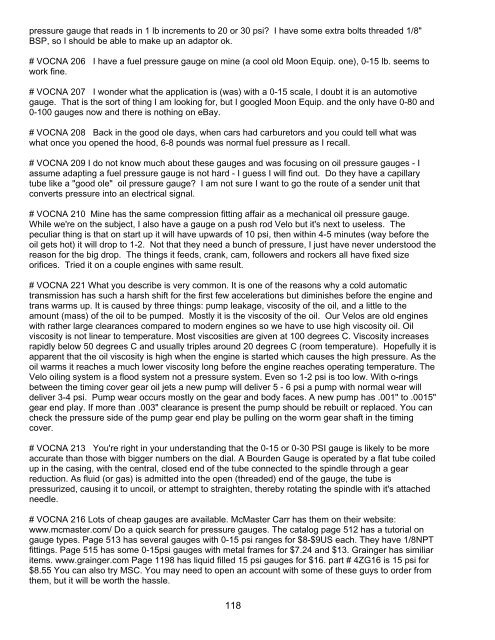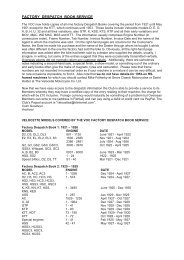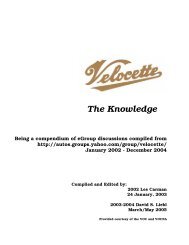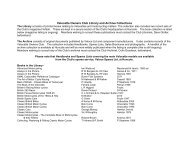The Knowledge - Velocette Owners Club
The Knowledge - Velocette Owners Club
The Knowledge - Velocette Owners Club
Create successful ePaper yourself
Turn your PDF publications into a flip-book with our unique Google optimized e-Paper software.
pressure gauge that reads in 1 lb increments to 20 or 30 psi? I have some extra bolts threaded 1/8"<br />
BSP, so I should be able to make up an adaptor ok.<br />
# VOCNA 206 I have a fuel pressure gauge on mine (a cool old Moon Equip. one), 0-15 lb. seems to<br />
work fine.<br />
# VOCNA 207 I wonder what the application is (was) with a 0-15 scale, I doubt it is an automotive<br />
gauge. That is the sort of thing I am looking for, but I googled Moon Equip. and the only have 0-80 and<br />
0-100 gauges now and there is nothing on eBay.<br />
# VOCNA 208 Back in the good ole days, when cars had carburetors and you could tell what was<br />
what once you opened the hood, 6-8 pounds was normal fuel pressure as I recall.<br />
# VOCNA 209 I do not know much about these gauges and was focusing on oil pressure gauges - I<br />
assume adapting a fuel pressure gauge is not hard - I guess I will find out. Do they have a capillary<br />
tube like a "good ole" oil pressure gauge? I am not sure I want to go the route of a sender unit that<br />
converts pressure into an electrical signal.<br />
# VOCNA 210 Mine has the same compression fitting affair as a mechanical oil pressure gauge.<br />
While we're on the subject, I also have a gauge on a push rod Velo but it's next to useless. <strong>The</strong><br />
peculiar thing is that on start up it will have upwards of 10 psi, then within 4-5 minutes (way before the<br />
oil gets hot) it will drop to 1-2. Not that they need a bunch of pressure, I just have never understood the<br />
reason for the big drop. <strong>The</strong> things it feeds, crank, cam, followers and rockers all have fixed size<br />
orifices. Tried it on a couple engines with same result.<br />
# VOCNA 221 What you describe is very common. It is one of the reasons why a cold automatic<br />
transmission has such a harsh shift for the first few accelerations but diminishes before the engine and<br />
trans warms up. It is caused by three things: pump leakage, viscosity of the oil, and a little to the<br />
amount (mass) of the oil to be pumped. Mostly it is the viscosity of the oil. Our Velos are old engines<br />
with rather large clearances compared to modern engines so we have to use high viscosity oil. Oil<br />
viscosity is not linear to temperature. Most viscosities are given at 100 degrees C. Viscosity increases<br />
rapidly below 50 degrees C and usually triples around 20 degrees C (room temperature). Hopefully it is<br />
apparent that the oil viscosity is high when the engine is started which causes the high pressure. As the<br />
oil warms it reaches a much lower viscosity long before the engine reaches operating temperature. <strong>The</strong><br />
Velo oiling system is a flood system not a pressure system. Even so 1-2 psi is too low. With o-rings<br />
between the timing cover gear oil jets a new pump will deliver 5 - 6 psi a pump with normal wear will<br />
deliver 3-4 psi. Pump wear occurs mostly on the gear and body faces. A new pump has .001" to .0015"<br />
gear end play. If more than .003" clearance is present the pump should be rebuilt or replaced. You can<br />
check the pressure side of the pump gear end play be pulling on the worm gear shaft in the timing<br />
cover.<br />
# VOCNA 213 You're right in your understanding that the 0-15 or 0-30 PSI gauge is likely to be more<br />
accurate than those with bigger numbers on the dial. A Bourden Gauge is operated by a flat tube coiled<br />
up in the casing, with the central, closed end of the tube connected to the spindle through a gear<br />
reduction. As fluid (or gas) is admitted into the open (threaded) end of the gauge, the tube is<br />
pressurized, causing it to uncoil, or attempt to straighten, thereby rotating the spindle with it's attached<br />
needle.<br />
# VOCNA 216 Lots of cheap gauges are available. McMaster Carr has them on their website:<br />
www.mcmaster.com/ Do a quick search for pressure gauges. <strong>The</strong> catalog page 512 has a tutorial on<br />
gauge types. Page 513 has several gauges with 0-15 psi ranges for $8-$9US each. <strong>The</strong>y have 1/8NPT<br />
fittings. Page 515 has some 0-15psi gauges with metal frames for $7.24 and $13. Grainger has similiar<br />
items. www.grainger.com Page 1198 has liquid filled 15 psi gauges for $16. part # 4ZG16 is 15 psi for<br />
$8.55 You can also try MSC. You may need to open an account with some of these guys to order from<br />
them, but it will be worth the hassle.<br />
118





